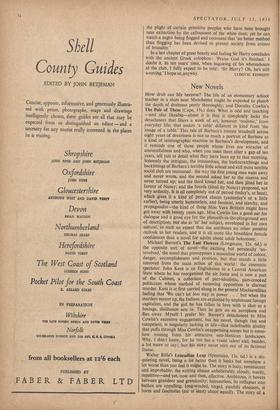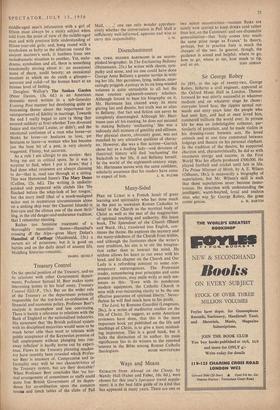New Novels
How drab can life become? The life of an elementary school teacher in a slum near Manchester might be expected to plumb the depth of drabness pretty thoroughly; and Dorothy Cowlin's The Pair of Them (Cape, I5s.) does. What is odd and touching —and also likeable—about it is that it completely lacks the detachment that filters a work of art, however 'realistic,' from everyday life; that makes 'a table' different in kind from 'the image of a table.' This tale of Barbara's minute treadmill across eight years of dreariness is not so much a portrait of Barbara as a kind of seismographic reaction to Barbara's development, and it reminds one of those people whose lives are miracles of uneventfulness and who, when you meet them after a gap of ten years, tell you in detail what they have been up to that morning. Solemnly the intrigues, the innuendoes, the backscratchings and backbitings of Barbara's terrible little school and still more terrible social club are recounted : the way the first young man went away and never wrote, and the second asked her to the cinema and never turned up; and the third kissed her, and then jilted her in favour of Nancy; and the fourth (jilted by Nancy) proposed, not very ardently. It is all completely out of period (today's, at least), which gives it a kind of period charm (yesterday's or a little earlier), being utterly humourless, and feminist, and starchy, and propagandist—the kind of thing Miss Vera Brittain might have got away with twenty years ago. Miss Cowlin has a good ear for dialogue and a good eye for the plimsolls-in-the-playground sort of description; but she is 'in' her subject, enveloped in her own naiveté, to such an extent that she attributes no other possible outlook to her readers, and it is all more like breathless female confidences than a novel for adults about adult behaviour.
Michael Barrett's The Last Flowers (Longmans, 12s. 6d.) is the opposite sort of novel—the exciting but personally 'un- involved,' the novel that presupposes a masculine world of colour, danger, accomplishment and position, but that stands a little removed from the main action of this world : the cinematic spectator. John Kent is an Englishman in a Central American State where he has reorganised the air force and is now a part of the Cabinet, a collection of part-idealistic, part-crooked politicians whose method of removing opposition is discreet murder. Kent is at first carried along in the general Machiavellian feeling that 'We can't let him stay in power . . .' but when the murders mount up, the Indians are exploited by unpleasant foreign capitalists, and the girl he has fallen in love with is shot as a hostage, disillusion sets in. Then he gets on an aeroplane and flies away. Myself I prefer Mr. Barrett's detachment to Miss Cowlin's excessive engagement, but his novel, though fast and competent, is singularly lacking in life—that indefinable qiiality that puffs through Miss Cowlin's unappetising scenes but is some- how missing from his attractive neo-Mexican landscapes. Why, I don't know, for he too has a visual talent and, besides. a lot more to say : but his story never stirs out of its fictional frame.
middle-aged man's infatuation with a girl of fifteen must always be a sticky subject when told from the point of view of the middle-aged man and with precious little understanding of fifteen-year-old girls; and, hung round with a symbolism as hefty as the albatross round the ancient mariner's neck, it lumbers from one melodramatic situation to another. Yet, melo- drama, symbolism and all, there is something emotionally stirring about it : an occasional scene of sharp, sunlit beauty; an occasional moment in which we do catch a glimpse— accurate and valid—of the human heart at an intense level of feeling.
Douglass Wallop's The Sunken Garden (Peter Davies, 13s. 6d.) is an American domestic novel written in a sub-Saturday Evening Post manner but developing quite an interesting theme about the importance (or unimportance) of fidelity in marriage. Towards the end I really began to care (a thing that seemed unlikely at first) whether Tom divorced Janice and married Louise, or didn't; and the emotional confusion of a man who loves—or thinks he loves—or hesitates to love, yet hesitates to leave—a woman who has become just the least bit of a pest, is very cleverly suggested. Flimsy, but accurate.
As a rule I am allergic to sea stories: they bring me out in critical spots. So it was a surprise to find, when I put it down; that I had done what reviewers are always claiming to do—that is, read one through at a sitting. This was Hammond lnnes's The Mary Deare (Collins, 12s. 6d.). The writing is undistin- guished and peppered with clichés like 'He flinched before the whip-lash of her tongue,' but the story itself (that of a much-maligned sailor met in mysterious circumstances alone on a sinking ship near the Channel Islands) is first-rate and the climax one of the most thril- ling, in the old danger-and-endurance tradition, that I remember meeting.
Rather too feminine treatment of a thoroughly masculine theme—Hannibal's crossing df the Alps—gives Mary Dolan's Hannibal of Carthage (Macdonald, 15s.) a certain air of prissiness; but it is good on battles and on the daily detail of ancient life. Middling historico-romantic.
1SABF.L QU1GLY



































 Previous page
Previous page